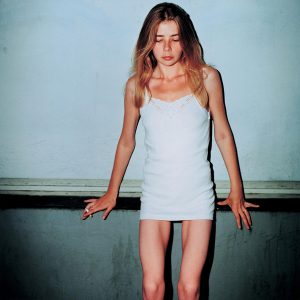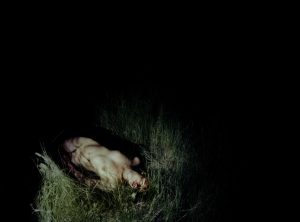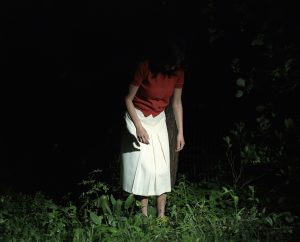
“And yet at the same time, I was so proud of my Baltic roots. Softly and tenderly, painfully and bitterly, as if they were the birth of my disabled child.” (Stalin’s Cows).
Sofi Oksanen is a literary sensation. Born in Finland in 1977, to a Finnish father and an Estonian mother, she writes in Finnish but calls herself a Finnish-Estonian writer. As a declared feminist, she speaks openly about men’s violence against women and Putin’s rule in Russia. She is internationally renowned, her novels have been translated into some forty different languages, and, she is the recipient – often, as the youngest writer ever – of several literary awards, the Finlandia Prize in 2008, the Nordic Council Literature Prize in 2010, and the Swedish Academy’s Nordic Prize in Literature in 2013.
Her principal topic is the bloody history of 20th Century Estonia, from the interwar years of liberation to the years as a German general commissariat, a Soviet republic, and as a free republic after the fall of the Wall. Sofi Oksanen has expanded the boundaries the Nordic and elevated Estonia to world literature by her novels Stalinin lehmät (2003; Stalin’s Cows), Puhdistus (2008; Purge, 2010) and Kun kyyhkyset katosivat (2013; When the Doves Disappeared).
Oksanen has created a hybrid novel – a mixture of historical and postcolonial novel, a historiographic metafiction with elements of documented witness literature. Her literary technique interweaves two systems of oppression: sexism and Soviet imperialism. Purge and When the Doves Disappeared introduces elements from thrillers and whodunits in order to create suspense. By alternating levels of time and action, the writer captures the confusion experienced by people living in the midst of chaotic events, fearing for their lives. This effect is reinforced by Oksanen’s frequent use of different narrators in the same novel, whose appearances, characters, or psychology she refrains from describing. Instead, she makes ingenious use of various forms of interior monologues. Estonian phrases may be used in order to emphasise the significance of the local, specific context. On the whole, the reader has the impression of being right at the very centre of events, however, every reader has to interpret the actual occurrences of the novels for themselves by piecing together fragments of the plot.
Moreover, the alternation between one epoch and another leaves the reader with a dizzying understanding of people’s dependence on ideological regimes, systems of control, power structures, and modes of production. While reading, one may reflect on a vast array of burning issues such as colonisation, the oppression of women, war, migration, trafficking, totalitarianism, illegal activities, patriotism, and nationalism. The novels are not historical or postcolonial in the strict sense of the term. Rather, they are updated versions of the rich – though largely overlooked – genre of women’s fiction. The narratives of Stalin’s Cows and Purge are demonstratively carried forward by the respective destinies of two and three generations of women.
Women’s Fiction
What are the characteristics of women’s fiction? Women’s fiction is a form of literature which always sides with women, portraying women’s existence as pivotal, and, rather than trivialising women’s suffering, women’s fiction takes this suffering seriously, rendering women as active participants in history at large and in their own individual destinies by removing the stigma of victimhood. Women’s fiction concomitantly “downgrades” man from golden standard to human being, criticising men’s oppression of women and misogynous behaviour towards women, and importantly: women’s fiction gives a voice to the female body in order to express hitherto repressed, social taboos of sexual experience. Oksanen may have learned to view her characters with a seemingly detached eye from Marguerite Duras, who is quoted in Stalin’s Cows. Doris Lessing may have taught her how ideologies have an impact of women’s bodies and life projects, and perhaps Christa Wolf taught her the dispassionate pathos of a strong narrator’s voice.

In The Seventh Spring of Peace (1990), Oksanen’s Estonian predecessor, Viivi Luikk, commits the ultimate transgression of the Soviet Era by portraying – through the eyes of a small girl – the brutal collectivisation of agriculture in the late 1940s and the early 1950s, when the “Forest Brethren”, fighters of the anti-Soviet resistance, were assassinated, and the hopes and aspirations for a free Estonia extinguished.
Purge, Oksanen’s hitherto most highly praised novel, alternates between the war and post-war period, 1939-1951, and the time of the fall of the Wall, 1991-1992. The main characters of these two epochs are the communist widow, the “red grandmother”, Aliide Trüu, and her young relative, Zara Pekk, a trafficked prostitute from Vladivostok. As is often the case in Oksanen’s novels, the story unfolds in a village in Western Estonia.
When read from Zara’s point of view, the novel is a thriller about human trafficking, the Russian mafia, and the ruthless exploitation of women’s bodies in brothels in Berlin and Tallinn. When Aliide is the main character, the novel reads like a Greek tragedy, haunted by a blow fly descending like a goddess of revenge at the very moment when Aliide encounters Zara. On the run from her pimps, the young woman collapses into a heap in Aliide’s yard. Zara turns out to be the granddaughter of Aliide’s sister, Ingel, who was deported to Sibiria in 1949 after being turned in by Aliide. When read together, the stories of Zara and Aliide form a hair-raising plot characterised by the structural similarities of the impact of oppression of women and colonisation on individual’s perceptions of self.
Zara is severely traumatised by the sexual exploitation she has endured in the sex industry. Aliide, having always worn two pairs of knickers since being gang raped (“interrogation”) by Soviet troops in the basement of the town hall, is the ideal subject of a story from the darkest chapter of modern Estonia, when, in 1944, the country was forcibly transformed into Estonskaja SSR, The Estonian Soviet Socialist Republic. Recorded as body memory, the oppression of women emerges as a constant, regardless of regime, epoch, and nation. When Aliide realises that the boots, cocks, and contempt for humanity of the Soviet Era continue to pound, rape, batter, and kill women, she has had enough. With the sang-froid derived from her years as a collaborator, she exacts revenge on the oppressors in order to rescue Zara – and take a stab at her own sense of shame. “If they’re coming, they might as well come – Mafia thugs, soldiers – Reds and Whites – Russians, Germans, Estonians – let them come. Aliide would survive. She always had” (Purge).
Estonian History
Aliide and Zara are both murderers of men. The crimes are inherent to the system, a consequence of always being the wrong gender in the wrong place at the wrong time. Like the small disaster-ridden country, Estonia, ruled by Danes, Germans, Swedes, and Russians, until, during a few decades between 1918 and 1939, it became a free and flourishing country. At the outset of the Second World War, Estonia had a population of 1,134,000, a million of whom had Estonian nationality. The war and resistance against the Soviet occupation in August 1940 and the Nazi-German occupation in June 1942 claimed the lives of more than a quarter of the population. A total of 70,000 people fled. In June 1941, 10,000 Estonians were deported to Russian labour camps, followed by a further 75,000 in October 1944. With the collapse of the Eastern Front in September 1944, 30,000 Estonians managed to cross the Baltic Sea and seek refuge in Sweden. Of those who remained in Estonia, more than 100,000 were deported to Sibiria in the cattle wagons of goods trains. Russians and Ukrainians were transferred to Estonia in order to replace the deported and the dead. In March 1949, during the annexation of Estonia by the Soviet Empire (1949-1991), 30,000 “enemies of the forced collectivisation of agriculture” – primarily women and children, since men of working age had either fallen in battle or taken refuge in the woods – were deported.
In Purge, Ingel’s husband, Hans Pekk, is one of the “Forest Brethren”, having deserted the German army in order to fight for a free Estonia under the auspices of Finland. His voice speaks to us through a secret diary found by Zara in Aliide’s private chamber without realising that it belonged to her own grandfather. The novel opens with his first diary entry dated May 1949. From the diary, we may glean that Hans, like many Estonians at the time, is a supporter of Churchill and a believer in the restoration of post-war independence, as stipulated by the Atlantic Declaration, whereby no territorial changes may be made against the wishes of the people. However, on 22 September 1944, the Soviet flag was raised on the Tall Hermann tower of the mediaeval castle on Tallinn’s Toompea Hill. The five days of independence following the German retreat had come to an end. The Estonian flag would only fly freely from the tower on 21 August 1991.
The Body as the Seat of Memory

Oksanen’s art of novel writing is thus also a lesson of history and a morality, extending into the present. Injustices of the past leave their mark on future generations, becoming festering, open wounds unless one puts an end to it. It is no coincidence that half-Estonian Zara becomes a victim of human trafficking in the system of Russian mafia capitalism, which has superseded the Soviet dictatorship. In the debut novel, Stalin’s Cows, the repression of her “disgraceful” Estonian heritage causes the young Finnish woman, Anna, to suffer from bulimia-anorexia. Her programme of self-starvation is compared to the sense of time among labour-camp prisoners in Siberia: “Weekdays have been reduced to 300-gram bread rations, and holidays a ladleful of soup”. Anna’s body becomes the carrier of her mother’s fear of social marginalisation in Finland, where Estonian women are regarded as Russian whores. “I have regurgitated all the opportunities you fed me”, she tells her mother. She only becomes “light without having to vomit” when she recognises her affection for all things Estonian as a “home”, she “wanted to starve her way into”. “The body bursts into bloom like springtime: catkins from willow trees emerge from my footprints, birch sap oozes from the folds of my knees”.
In feminist literature, the female body is remarkably often a site for memory, history, subjective experiences, and it is – due to patriarchal structures – a battle field for men’s propensity for violence. Oksanen affiliates herself with a strand of women’s literary tradition reaching back to Sappho, which finds bodily expressions for predicaments of the soul. In Stalin’s Cows, this is achieved by administering quasi-medical terminology in order to diagnose Anna’s increasingly desperate bodily decay. The sexual abuse, Aliide and Zara are subjected to, is described without the splatter effects of pornography, thereby enhancing their impact on the reader. Zara’s pain, when fainting after a violent client wore a “spiked ring around his dick and something else, too. Zarah couldn’t remember what it was” (Purge), is transferred to the reader. During the gang rape of Aliide, one is struck by her flight into alienation, seeing her own violated body from the outside: “She was a fly and she was walking over a woman’s naked breast, the woman was in the middle of the room with a bag over her head, and she was walking over a fresh bruise, the blood forced up under the skin of the woman’s breast, a running welt that the fly traversed, across bruises that emanated from the swollen nipple like the continents on a globe. When the woman’s naked skin touched the stone floor, she didn’t move anymore” (Purge).

Overall, the novels also constitue an important contribution to feminist debate. In an essay on silent narratology, Liian lyhyt hame (2011; Too Short Skirt – Tales from the Kitchen. A Collection of Poetry), Sofi Oksanen criticises, how violence against women is suppressed due to not being openly voiced in public debate. E.g. when “the freshness of the marks and their bloodiness” of Zara’s bruises causes sweat to trickle down Aliide’s upper lip. “The bruises were covered up again, and there was silence. That’s the way it always went” (Purge).
A Cross-Generational Sisterhood
Solidarity is the antidote to the evil perpetrated throughout time by men against women. The novel presents a female genealogy, described as a physically tangible cross-generational “sisterhood”. It is a kind of sisterhood, which cannot emerge between Aliide and her daughter, Talvi, because Soviet ideology forbids the It is a kind of sisterhood, which cannot emerge between Aliide and her daughter, Talvi, because Soviet ideology forbids her to “tell her any of the stories that she was raised on, she and her mother and grandmother and great-grandmother” (Purge).
Furthermore, Talvi is, unlike Zara, unable to spot the difference between a ladys’ mantle and a broadleaf plantain, or a toadstool and a milk-cap. Most importantly, Aliide and Zara share similar experiences of sexual torture, forever remembered by their bodies. Listening to Zara in 1992 makes Aliide recall memories from 1949: “When a person’s head has been pushed under the water enough times, the sound they let out is surprisingly consistent. That familiar sound was in the girl’s voice” (Purge).
Oksanen seems to argue that a shared history of oppression and liberation is a prerequisite for “sisterhood”, as if she were a relic of the 1970s Women’s Movement, obsessed with the ways of life and thinking of before her time. A crucial factor in determining Aliide’s decision to rescue Zara and give Ingel and Linda the chance to return to Estonia, is the familiarity of Zara’s Russian pimps when they track down Zara’s hideaway. Aliide immediately senses “the scent of a KGB officer through the horseradish. It wafted toward her like a musty cellar and made the wind that blew in the door bitter. Aliide started to breathe through her mouth. She knew men like these. Men with that kind of posture, men who knew how to punish a woman, and they were here to get a woman, and punish her” (Purge).
The Forbidden Mother Tongue

The reason for Aliide and Zara finding a way to each other in spite of all the let-downs constitute one of Oksanen’s most powerful themes: The forbidden mother tongue, its taste of a lost homeland, maternal love, and repression. There is something in the archaic Estonian of exiles which makes Aliide retreat into her shameful family history: “But this girl’s Estonian had a different flavor, something older, yellow and moth-eaten. There was a strange smell of death in it” (Purge). Thus, a sense of foreboding is raised concerning Hans Pekk’s, Aliide’s brother-in-law, whom she killed and buried underneath the floor in her cottage after his rejection of her.
There is a particular covenant between a woman’s body and her mother tongue in Purge. “Emasüda”, mother’s heart, is the keyword Zara uses to unlock her grandmother’s indifference to the exile in Vladivostok. Emasüda is also the name of a famous poem, forming the lyrics to a popular song, written by the Estonia’s national poet, Lydia Koidula (1843-1886). Small Zara is brought to life as an individual by Oksanen, when she utters this word from her maternal heritage which is banned in the Soviet Union.
“Grandmother looked at her, looked straight at her for the first time, and Zara felt her gaze press itself through her eyes and right into her – into her mouth, her throat – and she felt her throat tighten, and her grandmother’s gaze sank down her throat toward her heart, and her heart started to strain, and it sank from her heart to her stomach, and her stomach started to churn, and it sank to her legs, which started to tremble, and from her legs it sank into her feet, which started to tingle, and she felt hot, and Grandmother smiled. That smile became their first game, which sprouted word by word and started to blossom mistily, yellowish, the way dead languages blossom, rustling sweetly like the needle of a gramophone, playing like voices underwater. Quiet, whispering, they grew their own language. It was their shared secret, their game” (Purge).
The Estonian language thus becomes the sweetest tongue, as Zara is rewarded with sweets every time she speaks the language correctly.
Somatic and Materialistic Language
Oksanen’s somatically charged writing imbues physical reactions with symbolic meaning: Sweating with fear, involuntary shivers, stomach aches, migraines, panic attacks, the trembling of a voice or, as seen above, physical well-being.
“The sour stench of frightened people” prevails in the Marxist-Leninist slave society. When Aliide, in order to protect herself, seduces the party activist, Martin, she tries to express the look of “a new-born calf”. Only the equal sexual encounter between the patriots, Roland and Juudit, in When the Doves Disappeared engenders a woman’s neck, with a “nape soft as if in a time of peace”.
Estonian cuisine serves a particular purpose in Oksanen’s novel. Her literary language is materialistic, saturated by her love of all aspects of women’s labour in agrarian society: canning mushrooms and vegetables, making soap, mixing marigold ointment, kneading sourdough, milking, harvesting, the herbal remedies. But also the antithesis of the ice-cold shortage society of a centrally-planned economy: decay, drunkenness, sweat, revolting blow flies, the rotting meat, and maggots, washed off the sausages before throwing them across the counter, the insipid cereal coffee substitutes. In Oksanen’s novels, food prepared without love is automatically a recipe for poor digestion. Metaphors remarkably often hail back to subsistence farming: “The air fell upon her skin like freshly-milked milk”, “her laughter was rippling with fear, like a bucket brimming with water”, disappointment is “like the rotten core of an onion”, days pass “like mushrooms drying on a tray”, one grieves “like a tobacco leaf hung out to dry, sweating as if my heart were in a fermentation barrel”.
When, in Stalin’s Cows, Anna begins to long for sauerkraut soup and sour cream, we suspect that she will prevail on her “Master”, anorexia. Edgar Parts, whose wife despises him, is never offered prepared food in When the Doves Disappeared. He looks gloomily into the empty refrigerator every single night, noting the bottles of curdled milk. For his lonely worktop-dinners he dips a slice of bread in clotted lard, sucks on a cold pig’s trotter, or opens a jar of pickled herring. If we had not already realised this, these scanty meals tell us that Edgar is a cruel man, condemned in advance by the writer.
Truth Versus Propaganda
Interestingly, Edgar, the vehicle of the linguistic theme that is so important to Oksanen, is the central character of the novel. When the Doves Disappeared differs from Oksanen’s previous books as it is about two men and two women. The novel alternates between the 1940s and the 1960s, contrasting the Nazi occupation to the era of Soviet dictatorship. Edgar’s cousin, Roland Simson, is his absolute opposite, a resistance fighter documenting Russian violations in Estonia in code for the purpose of a future tribunal. To Edgar, the act of pronouncing the name of Roland, the patriot, is “like getting blisters on the tongue”.
In fact, Edgar is a collaborator, a careerist, and a mass murderer – first, in the service of the Germans, subsequently in the service of the Russians. By chance, he finds Roland’s oil-cloth notebook in the archive, when, in 1965, he has been selected to write a propaganda novel about the “Hitlerian” atrocities. Edgar is puzzled how Roland, having “dwelled in the valley of death without any chances of returning to ordinary life”, could ever believe that “one fine day, someone would lend him an ear.” When the Doves Dissappeared is a metanovel about the uses of literature – as disclosure and prevarication – according to the censorship needs of political regimes. Roland, considers Edgar, was obsessed by “the delusion that the truth shall finally be heard”. Presumably, this is also Sofi Oksanen’s ethos as a writer.
There is reason to dwell on Oksanen’s perception of men. While Roland is the anti-hero, appearing as a true patriot and a decent human being through most of the book, he nevertheless emerges as cut from the same cloth as the majority of drunken, unfaithful male characters in the writings of Oksanen. Men are judged, in accordance with the canons of women’s fiction, by how he relates to women. Oksanen may harbour a degree of sympathy for men, such as the three dull partners in Stalin’s Cows, who may be used as a cover for a woman’s anorexia. Or men may be used, like Joonatan in Baby Jane (2008; Baby Jane) in order to overcome the lesbian love of the first-person narrator in the novel – incidently, Oksanen’s only work lacking an Estonian dimension thus far.
Baby Jane takes place in the gay and lesbian community of Helsinki during 1995-2002 and chronicles a fatal lesbian love triangle. Here too, one finds a pointed critique of heterosexual men’s incomprehensible and ridiculous sexual desires. The narrator is a “femme” who runs a mail-order business, “Susanna, Belle-de-Jour”, with her lover, “the coolest lesbian in town”, the “butch” Piki, selling used knickers, nylons, and tampons. (“We (…) struck right into an ore of sperm…”).
The passion fades when it turns out that Piki suffers from panic disorder, rendering her completely dependent on her ex-partner Bossa. When Piki takes her own life, Bossa ensures that the first-person narrator is apprehended for murder, and as a reader, one realises that the entire story is written in the prison cell. Apart from the erotic depictions, this is hardly a flattering portrayal of lesbian love, it is, however non-judgmental, not least when compared to the portrayal of the closeted gay man, Edgar, in When the Doves Disappeared. He is judged, not because he is gay, but because he is a dishonest man. Edgar, who marries Juudit in order to conceal his homosexuality, thereby making his wife utterly despondent, is condemned just as harshly for this deceit by Oksanen, as she judges him for his war crimes and treason. His despicable and reprehensible propaganda piece – quoted mercilessly in the novel – is possibly the worst of all crimes. Oksanen tenderly compensates Juudit for her loveless marriage by allowing her to experience two entirely plausible love affairs, with SS-Hauptsturmführer Hellmuth Hertz (heart!) and, subsequently, with Roland. A girl, Evelin, is born, getting into trouble after participating in an illegal student demonstration in the final part of the novel. Edgar seemingly comes off victorious by becoming a celebrated communist writer. However, the last words of the novel are left to Roland’s fiancée, Rosalie, as Edgar recalls strangling her in 1942, because she threatened to expose his homosexuality.
Maternal Genealogy
Sofi Oksanen returns to her starting point with the engineering student, Evelin, from When the Doves Disappeared. Stalin’s Cows is not only about Anna, but also about her grandmother, Sofia, and her mother, Katariina, a bachelor of engineering who falls in love and marries a Finnish construction worker in 1970s Tallinn. Since Katariina is unable to obtain a work permit in Finland, she supports herself and her daughter by selling Finnish clothes in Estonia. Anna grows up accustomed to visiting her maternal relatives in Estonia, and to her, the Soviet era signifies a sense of home. “This is Anna’s own world. Anna’s world is the world in which Anna’s mother is happy.” In addition to Anna’s mother being upset by Anna’s father’s infidelities with various “Tatianas” during travels for work to Russia, Anna is soon taught to dislike her father and his Finnish family’s disdain for all things Estonian.

Sofi Oksanen quite evidently finds that women are the bearers of the world men destroy. In Purge, order is restored, when Ingel, the sister rejected by Aliide, is introduced into the narrative through Zara’s longing to be somebody other than “Natasha”, the forced prostitute, whose bodily functions are the property of her pimp. Back on the family farm in Estonia, she adopts the shape and identity of her beloved grandmother, Ingel. It other words, it is thus the maternal genealogy which rehabilitates Zara and re-establishes her sense of human dignity.
“The grass that tickled Zara’s foot was her grandmother’s touch, and the wind in the apple trees was her grandmother’s whisper, and Zara felt like she was looking at the Big Dipper through her grandmother’s eyes, and when she turned her face back up toward the sky, she felt like her grandmother’s young body stood inside hers, and it ordered her to go back inside, to search for a story that she hadn’t been told” (Purge).
Decolonization as Literary Strategy
When the Doves Disappeared is about the story, which should remain untold. The atrocities committed by the Germans and Russians during the war, the merciless labour camps with the ruthless exploitation raw materials such as oil shale, the terror, and the deportations. However, the most important theme of the novel is the destructive impact of Soviet dictatorship on Estonian identity. This impact is masterly captured by Oksanen, through Edgar’s writerly battles with the euphemisms of propaganda language, a code which created an “alternative reality”. The disproportionate relationship between personal and official memory forced people to develop “stratified personalities, double identities” characterised by a sense of guilt and shame.
Oksanen describes the idea behind When the Doves Disappeared in Litteraturens Kraft (The Power of Literature), the speech she gave when awarded the Nordic Prize in Literature by the Swedish Academy in 2013. Through “decolonisation”, she wants to demonstrate how power structures, operating on various levels, permeate and shape the self-image of the colonised individual. In order to overcome this self-denial, shame must be transformed into anger. Oksanen thus wishes to give terror a human face, demonstrating that the perpetrators are never forgotten. The gendered divison of the world, along the lines of a feminism of difference, is due to the fact that dialogues with the past and trauma therapy is a theme, which is usually associated with the female characters of her oeuvre. Crimes against women must also be given a human face, named beyond the passive tense of propaganda language. Hence, Oksanen specifies the henchmen of Russian mafia capitalism as well as Nazism, Communism. These men are never quite as brutal as when it comes to mistreating women, human dignity is never quite as violated as in the case of sexual abuse. Hence, in Purge, Aliide, Zara, Ingel, and her daughter, Linda, are all colonised Estonian subjects in various regions of the Soviet Empire. Aliide is the most obvious post-colonial heroine. Despite her outward displays of collaborator-Communism, she privately resists Soviet ideology’s attempted eradication of patriotic feelings by way of her Estonian cooking. She also moves from internalised shame to openly-expressed anger, when, at the end, she kills Zara’s pimps.
The dual focus on the effects of dictatorship and sexism on Estonian subjecthood is pronounced in the titles of the novels, which masterfully capture the twin agendas of her oeuvre. Stalin’s Cows, a popular Estonian designation for the gaunt goats of Siberia, is a suitable double exposure of the history of Soviet deportations and Anna’s anorexia. In turn, When the Doves Disappeared alludes to the fact that while the Germans considered pigeons a delicacy, the Estonians found the practice of eating pigeons outright barbarian, akin to eating rat meat. The title of the novel thus comprises the condescending eye of the colonised on the coloniser, the seed of resistence, defining Estonians as the more civilised people. Purge’s Finnish title, Puhdistus, literally means cleaning up, whitewashing. It is an ambiguous title: on the one hand, the large-scale ethnic cleansing perpetrated by the Soviet forces in Estonia, and on the other hand, a whitewashing of the shame of rape in the form of Aliide excessive attempts, over the years, at scrubbing away her shame. Oksanen’s writings are thus also an endeavour to show how the destiny of the single individual is intertwined with the history of the nation.
– – –
Published december 2014

